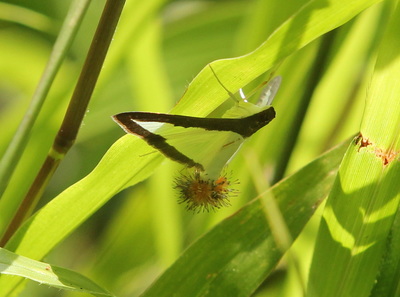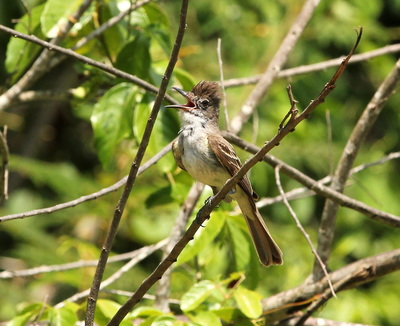|
Soroa is a wonderful place for wildlife. We were up early for a walk around the gardens to see what birds were about first thing. I spent some tome photographing both west Indian Woodpecker and Northern Flicker that were finding insects probably ants along the edge of the paths and at the base of one particular tree Roystonea regia or Royal Palm, the national tree of Cuba. Many of the trees in the hotel grounds are huge, this one included. On our previous visit here we had spent an afternoon in the Orchid Garden next door but the weather wasn’t great and we had therefore seen few butterflies. We had previously been told that the area at the top hill behind the Orchidarium was excellent so we planned to go up in the vehicle and walk down looking to see what we could find on the way. The view at the top was fabulous and while waiting for the weather to warm up a little we found several Sleepy Orange Abaeis nicippe larvae. At the top here I also found a larval shelter on a low plant about a foot off the ground which when opened we thought was Common Long-tailed Skipper Urbanus proteus. It was only a few days ago when going through and checking the pictures that I started having doubts - especially the hairy head that just didn't seem right. A few emails with the guys in Cuba and it looks like we seriously slipped up at the time. It looks like the larva of the the rare and endemic Cuban Longtail Chioides marmorosa! If you click here you can read more about this fabulous butterfly that was only rediscovered in 1993 and for which larvae were first found in 2014. If I had realised that at the time I would have kept it and bred it through to be sure and the plant it was on doesn't appear to be Hebestigma cubense which adds to the mystery. Maybe it is just a Common Long-tailed Skipper Urbanus proteus larva as they are very similar. An attractive Pyralid Diaphania sp. was sitting in the grass. It was a female and releasing pheromones to attract a mate. As soon as the temperature rose a little there were Dusky Emperor, Iphicleola Sister and Silver Emperor flying about and settling to warm up in the sun. There were also a few White-fanned Anoles Anolis homolechis up here and the males were displaying to each other by flicking out their dewlap. In this species it is white as the name suggests but each species differs. Here at Soroa there 25 species of lizard including a remarkable 11 anole species. We only saw three but included one of the most remarkable - more on this later! If you click here you can read a very interesting paper on the habitat niches adopted by the different Anolis at Soroa and how this might serve to reduce competition. On our way down we saw four Swallowtail species including Cuban Kite E. celadon and about six Polydamas nectaring on the Tournefortia flowers. All were very worn as can be seen below. You can also see the fuller more rounded wings of the females (above) as this one was pursued relentlessly by a male. We also saw a male Atalopedes mesogramma Mesogramma Skipper. We have seen females a couple times previously, which differ in having a white bar on the underside hindwing, but never a male . La Sagra's Flycatcher is a common permanent resident endemic to the Caribbean found only on Cuba, Bahamas and Grand Cayman. We saw it quite often but today whilst photographing the polydamas one came down to dustbathe behind me and then sat up panting in the heat - it was over 30⁰ by now. And then a Red-striped Leafwing Siderone galanthis appeared and flew round before settling on a bush about ten metres away. Panic - I took two slow steps towards it and it flew again before settling in the same place. We had seen this species first in March in the Sierra Maestra but only very briefly, and again on the Guanahacabibes peninsular last week but got not a sniff of a photo. While it flew the second time a rattled off a few pictures on the off chance of getting something in flight and I got a couple more this time when it settled before it shot off down the track and didn't reappear. Not great shots but it was something and the best views we had had so far. They belong to the Sub-Family Charaxinae in the Nymphalidae - what a stunner! By the side of the road was a small hut that was being built of blockwork, the mortar for which had been mixed by the roadside and on which various butterflies were taking moisture and minerals including several very smart freshly emerged male Marpesia chiron Many-banded Daggerwing. And further down lots more butterflies appeared on the verge, several species of Skipper, a Malachite Siproeta stelenes and the ubiquitous Anartia jatrophae White Peacock. As we neared the bottom of the hill a group of people were walking up and I got chatting to the father of a small boy that I thought was holding a plastic snake so I didn't pay much attention. It was only as they were leaving that I realised that it was alive - and of a species that we hadn't seen before Cuban Lesser Racer Caraiba andreae. I hope he let it go safely. We also found more Oviedo's Swallowtail larvae of all sizes feeding on Piper peltatum. Most interesting was the final instar that when seen head-on showed a remarkable resemblance to a snake - isn't evolution amazing! All in all a fantastic day with 52 butterfly species seen, that's about 30% of all the resident species in Cuba in one day - and all within about one mile!
Comments are closed.
|
Welcome to our Blog
Here we will post interesting news about what we and others have seen in Cuba. Archives
March 2024
Categories |


























 RSS Feed
RSS Feed